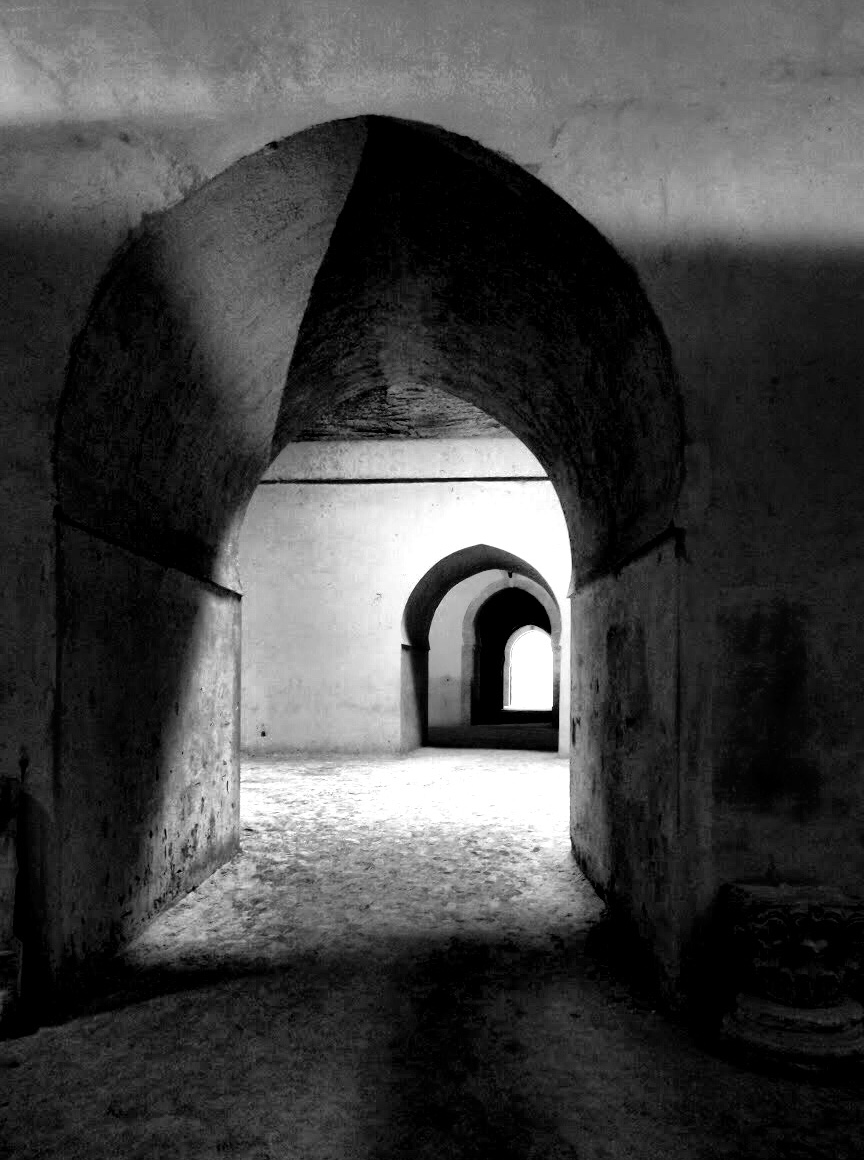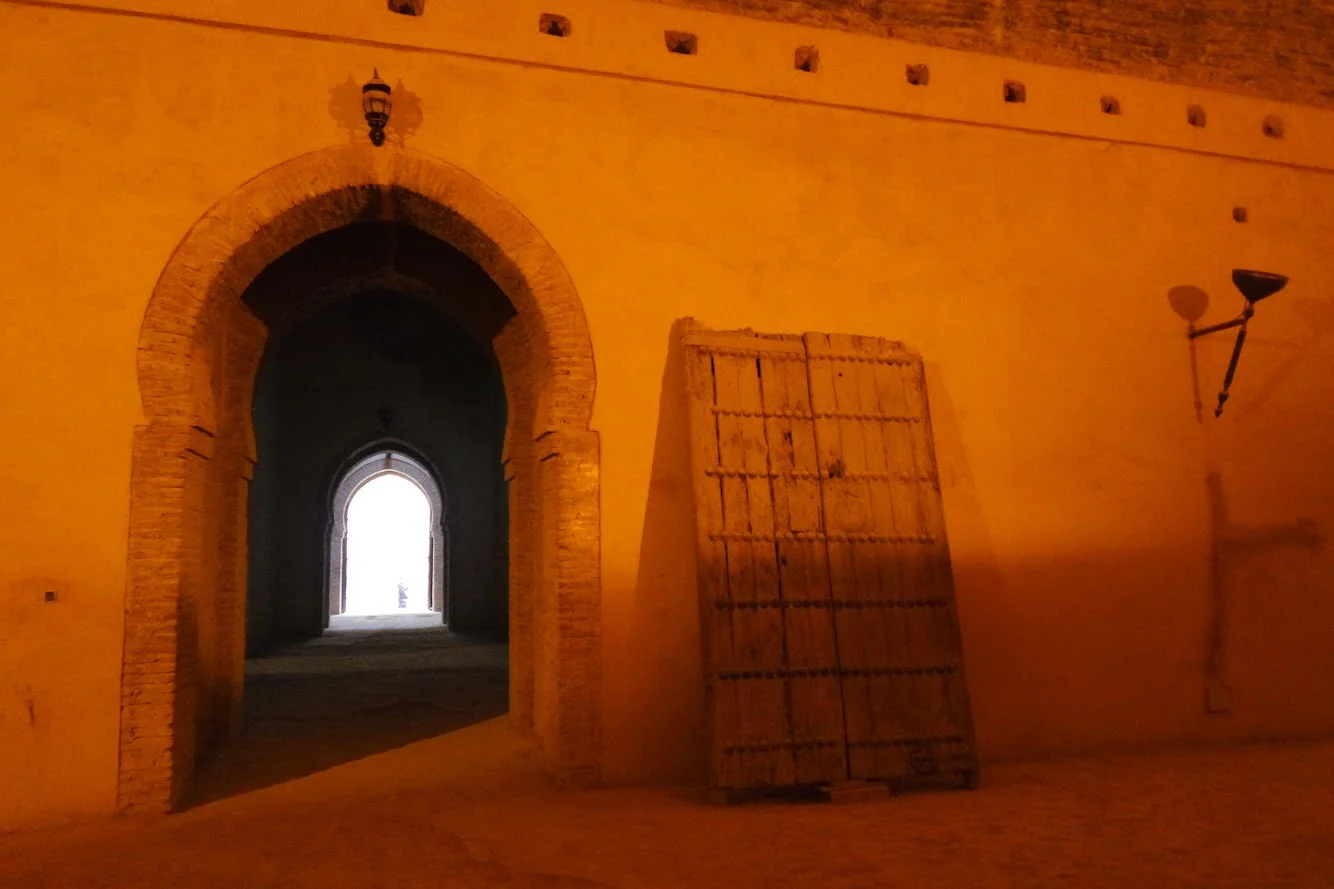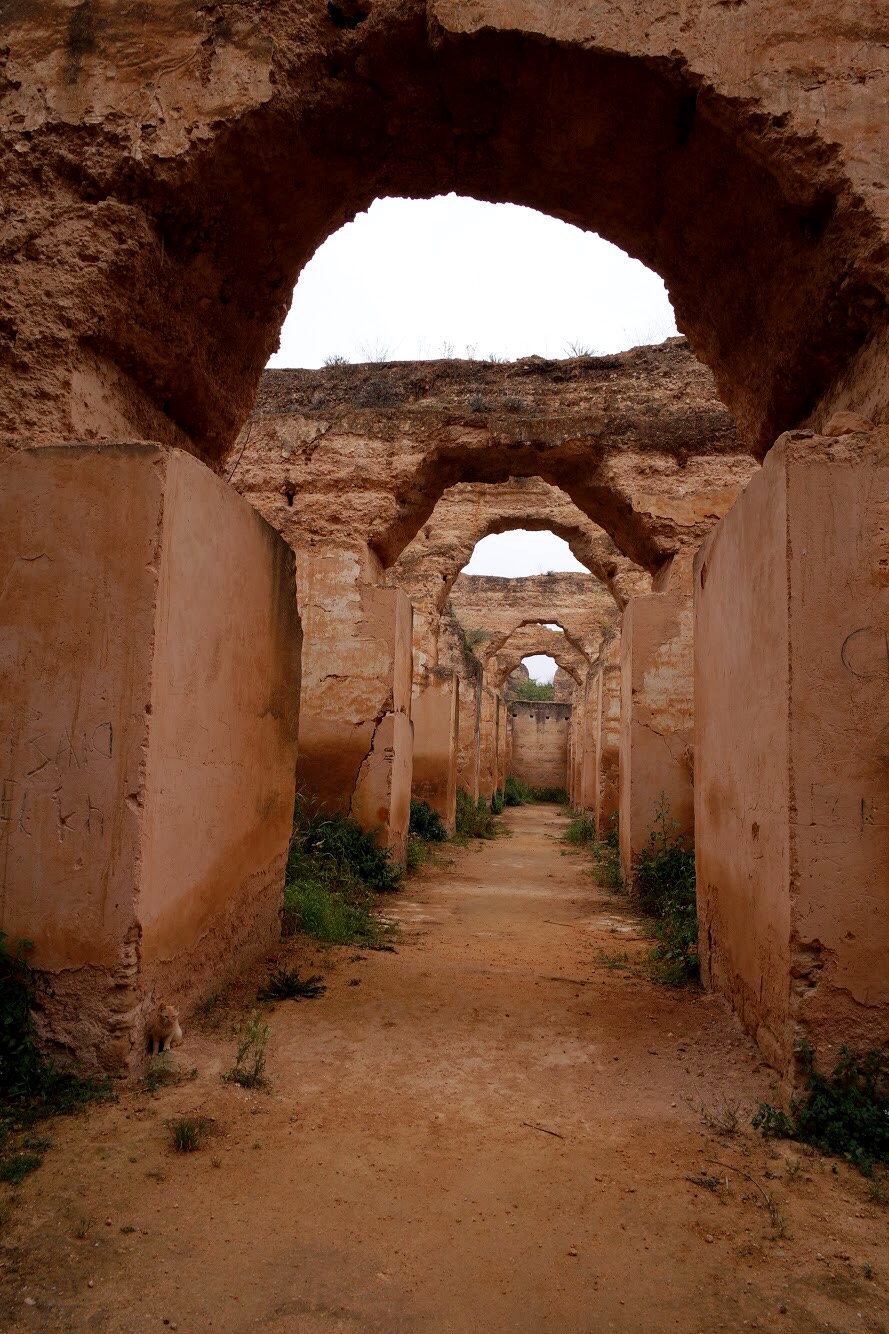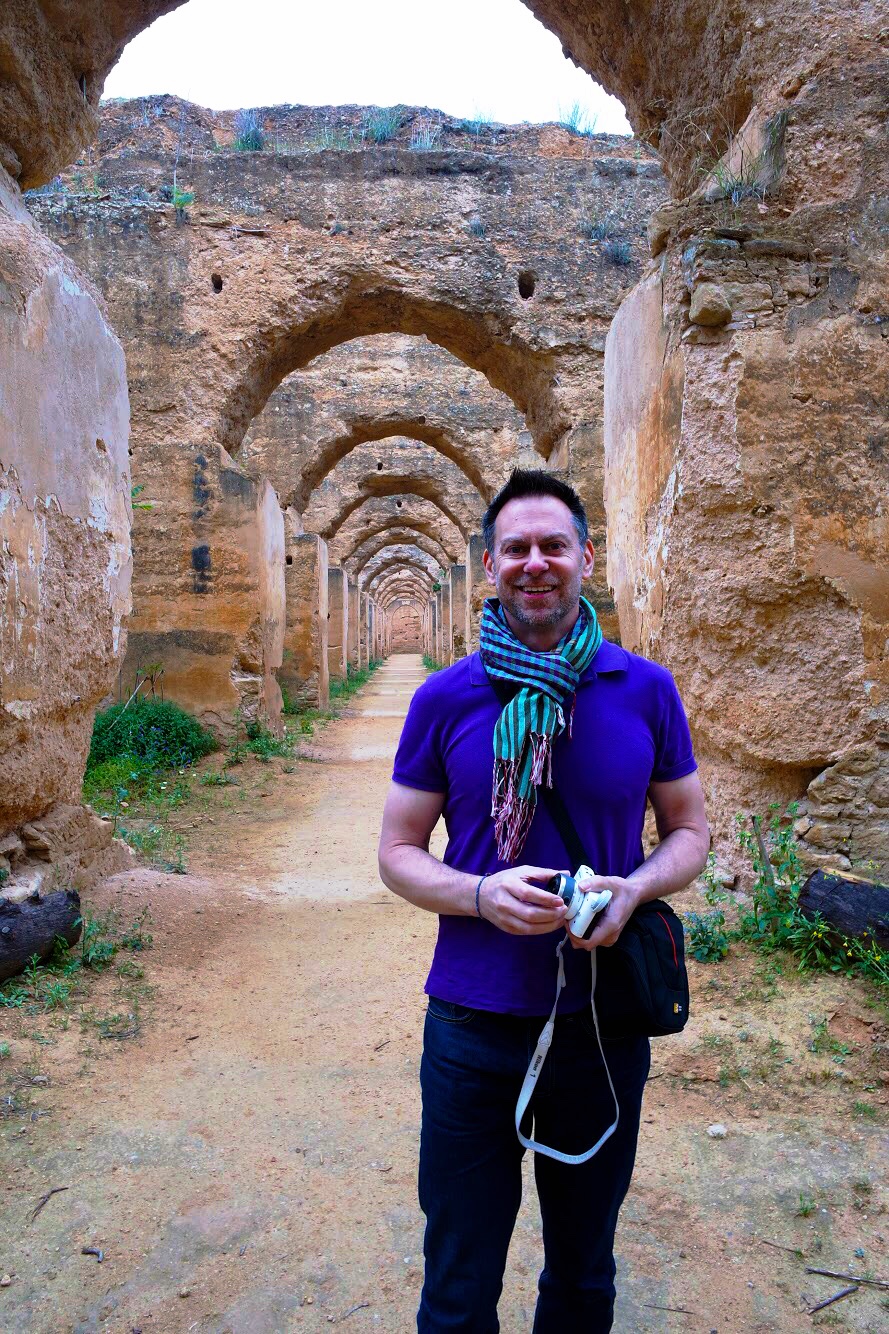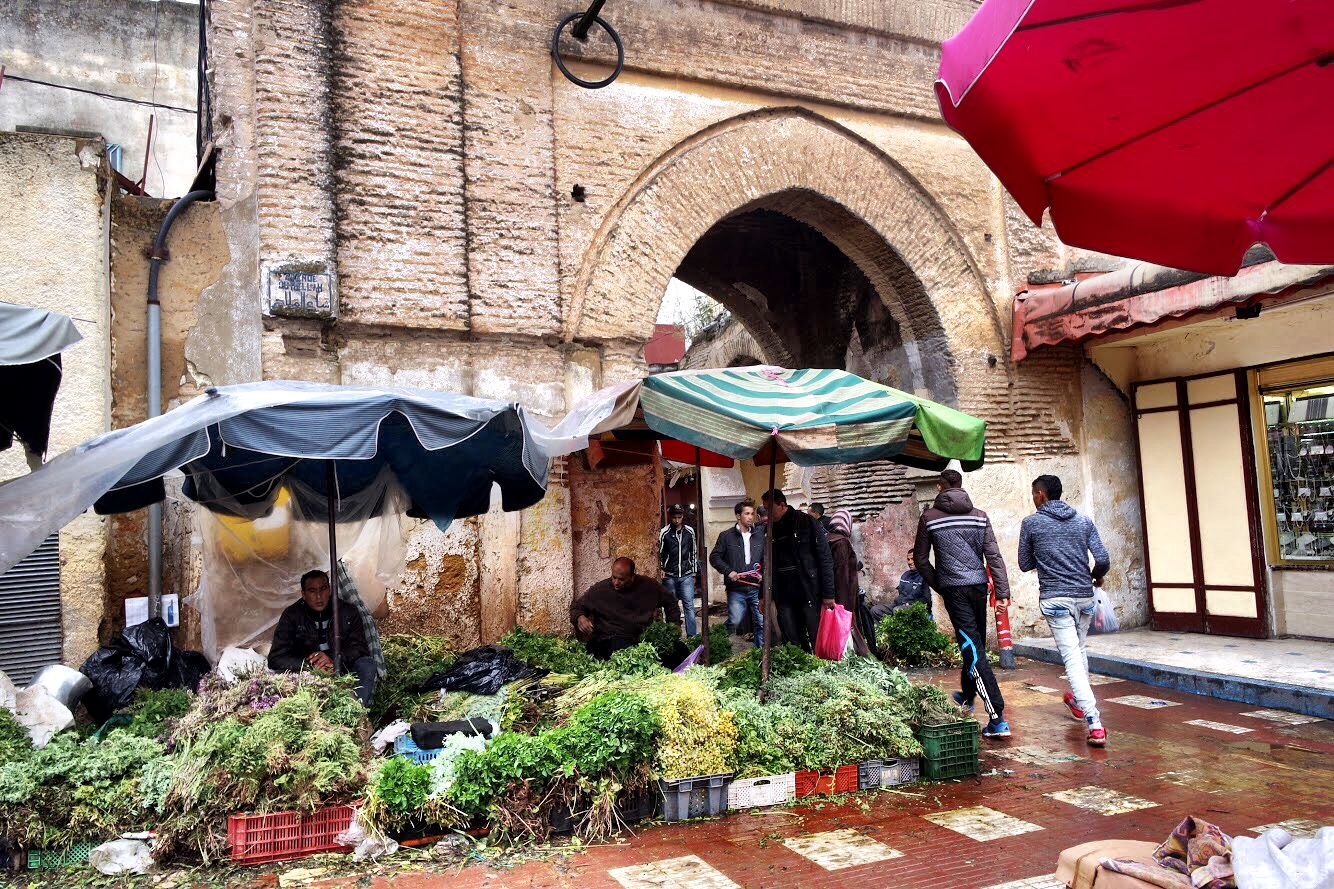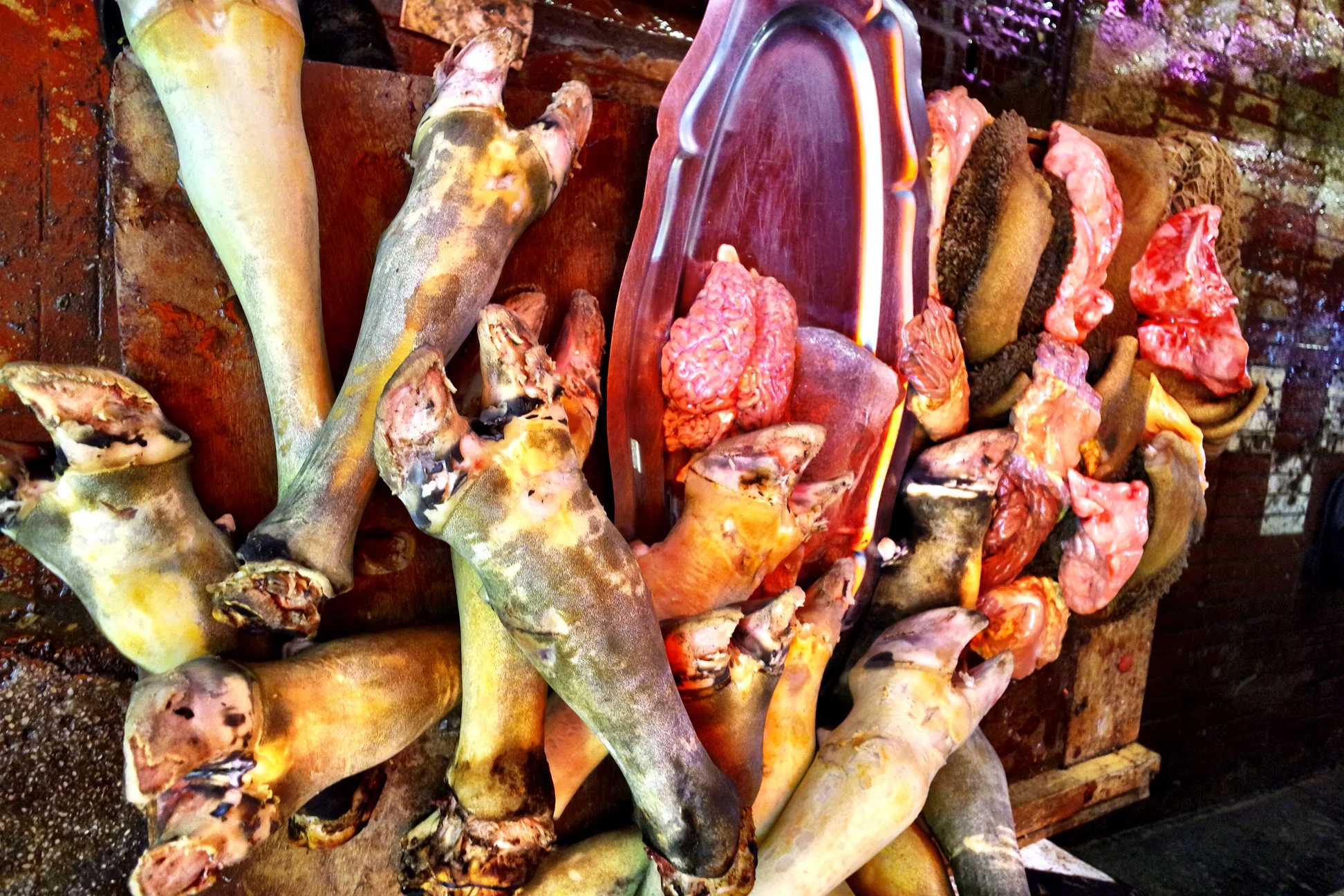Explore the historic gate, stables and medina on this day trip from Fès that can be paired with Volubilis.
Meknès, with its ruined stables, granary, gate and markets, makes for a fun afternoon after touring the ancient Roman mosaics of Volubilis.
One of Morocco’s four old imperial cities, Meknès lies west of Fès, in the foothills of the Middle Atlas Mountains. Our driver, Hafid, suggested we make a stop after our amusing guided tour of Volubilis.
“Isamil was given the epithet “the Bloodthirsty” for his legendary cruelty. To intimidate rivals, he once ordered that the walls of Meknès be adorned with 10,000 heads of slain enemies. ”
A woman sells dates off of the main square.
There weren’t as many cats in Meknès as there are in Fès and Marrakech, much to Duke and Wally’s dismay.
A vendor sells greens near one of the arches of the old city.
Meknès was founded and settled in the 11th century by the Almoravids, a Muslim Berber dynasty, as a military settlement and received UNESCO World Heritage Site designation in 1996. The city has retained many of its historic elements, which can be attributed to the ambitious 17th century transformation and monuments constructed under the rule of Sultan Moulay Ismail Ibn Sharif.
A stamp depicting Moulay “the Bloodthirsty” Ismail Ibn Sharif
The second sultan of the Alaouite dynasty (the current Moroccan royal family), Ismail ascended the throne at the age of 26, after the death of his half-brother Moulay al-Rashid, who died after a fall from his horse. A descendent of the Prophet Mohammed, Ismail moved from Tafilalt and made Meknès the capital, intent on a creating a grand city on a scale rivalling Versailles in France. It’s believed that Ismail enlisted over 25,000 Christian prisoners and over 30,000 criminals as laborers in the construction of Meknès. Some of the stones were taken from the ancient Roman ruins of Volubilis, a highlight of this area.
Meknès is much less touristy — and much easier to navigate — than Fès.
The market displays, like those of this fruit and veggie vendor, are works of art and riots of color.
Off to one side of the main square, a doorway leads into a teeming local market.
Ismail is remembered as one of the greatest and most notorious monarchs of Morocco. His reign lasted 55 years, from 1672 to 1727 — longer than any other ruler in Moroccan history — and left an indelible mark on Meknès. He was given the epithet “the Bloodthirsty” for his legendary cruelty. To intimidate rivals, Ismail once ordered that his city walls be adorned with 10,000 heads of slain enemies. Legends of the ease in which Ismail could behead or torture laborers or servants he thought to be lazy are numerous. During the half century of Ismail's rule, it’s estimated he killed 30,000 people.
The Bab el-Mansour gate was constructed to impress visitors — and doesn’t really lead anywhere.
Bab el-Mansour, the Gate to Nowhere
As a tourist in Meknès, you’ll feel like you’re stepping back in time. One of the most well-preserved and beautiful historic landmarks of the city is the Bab el-Mansour. The elaborate horseshoe-arched gate and its 52-foot-high wooden doors is located off the sprawling el-Hedim square and provides a glimpse of Ismail’s grand vision. The monumental gate bears an Arabic inscription that translates as “I am the most beautiful gate in Morocco. I’m like the moon in the sky. Property and wealth are written on my front.” What’s truly interesting though, is that unlike other gates we’ve encountered in Morocco, this one is a folly that leads nowhere and was commissioned by Ismail simply to impress visitors. It’s now the entrance to a building that features art exhibits.
Could the gate be more beautiful? Probably.
To further illustrate his cruelty, one popular legend tells the tale of Ismail asking Mansour Laleuj, the architect responsible for the impressive city gate if he could have made the gate more beautiful. When Laleuj responded yes, the sultan immediately had him beheaded. This is unlikely, though, as the gate was completed by Ismail’s son, Moulay Abdallah, in 1732 — five years after his father’s death. However, the notion that the sultan would act so impetuously at the slightest offense makes for a great story.
Nature has taken over the massive stable complex.
Stable Conditions
Equally impressive is the Heri es-Souani, the former imperial granary and royal stables. A remarkable engineering feat, the massive stable yard was constructed to comfortably house no less than 12,000 royal horses. I can only imagine the amount of shit there was to shovel! It has been said that Ismail was a fanatic about his horses, and two slaves were employed to look after each horse to ensure that all their needs were met.
The granary complex was an architectural marvel of its day.
The granary was empty when we visited, lending it a creepy vibe.
Underground cisterns kept the granary nice and cool.
One Great Granary
We entered the complex and found ourselves in a cool, barrel-vaulted structure. The chambers are constructed of 13-foot-thick adobe walls with small rectangular windows overhead for circulation. Many chambers have their original cedar doors.
Be sure to look for the noria, a water wheel half submerged in the sandy floor, where horses were once used to raise buckets of water from an underground reservoir connected to the nearby Bassin de l’Agdal.
A series of cisterns beneath the granary kept the floors cool, perfect conditions for storing provisions to feed the city and the sultan’s precious horses.
The stables are impressive — because the sultan who built them pampered his horses.
Sturdy stone arches once supported the roof of the stables.
Duke ponders the M.C. Escher-esque labyrinth.
Golden Arches
Stretching beyond the granary are the ruins of the royal stables. The wooden beams are long gone due to the seismic waves that radiated from the Lisbon Earthquake of 1755. Nary a horse in sight, its walls remain intact with a great forest of columns and open-air arches forming the arcades of the massive stable. Nature, as well as a few cats, have taken over, lending an otherworldly quality to the ruins.
Wally likes to pretend that he’s playing real-life Dungeons & Dragons in settings like this.
Duke thinks the seemingly neverending archways are a photographer’s delight.
Regarded as one of Ismail’s finest architectural achievements, the stables are a testament to his immense wealth and the great lengths he went to ensure that his horses lived comfortably.
The ruins of the stables are a favorite with film scouts.
Additionally, filmmakers are drawn to this amazing structure. The site has been featured in Ishtar, The Jewel of the Nile and The Last Temptation of Christ.
The medina in Meknès pales in comparison to Fès’.
If you’re looking for a day trip from Fès, Meknès makes for an interesting place to spend an afternoon exploring. –Duke













